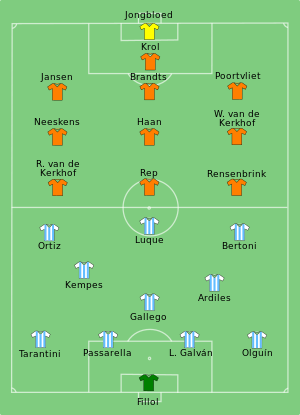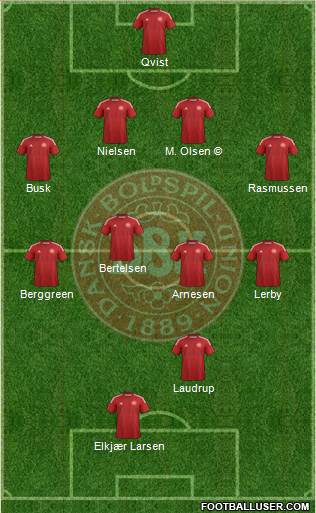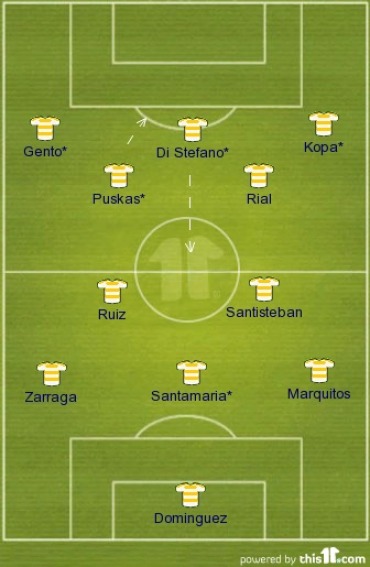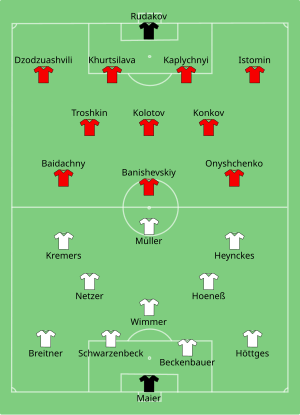Annahnomoss
Full Member
- Joined
- Oct 4, 2012
- Messages
- 10,101
Only the players performance in the chosen tournament should be considered.
Substitutes: Schiaffino, Jorginho, Hassler
Formation: lopsided 4-3-3
Tactical Synopsis: A moderate-deep defensive line shielded by a rugged central midfield pairing and augmented by tireless workers further up the pitch. Fast transitions and a high tempo attacking style orchestrated by Platini.
The team is built around Michel Platini at the absolute peak of his powers. Platini in his Euro ’84 pomp is without question one of the greatest match winners in this draft – a playmaker of outstanding influence and passing range, and a lethal goalscorer who hit 9 goals in 5 games. We’ve given him free rein as playmaker here, with complete licence to roam and to orchestrate our attacking game. Platini’s supporting cast in midfield and attack should complement his game nicely:
1) Elkjaer: The bruising, bullying battering ram who will lead the line while Platini starts moves from deeper areas, and moreover an extremely mobile livewire who will drag defenders all over the place to create space for Platini and Kempes to surge into.
2) Kempes: Another bona fide match-winner, who shares Platini’s penchant for quick tempo, thrusting attacking moves. A wonderful outlet for Platini’s passing, and his chaotic, hyperactive style of dribbling and quick interchanges should create plenty of opportunities for Platini in return.
3) Ghiggia: As an orthodox winger he’s in some ways atypical for a Platini side, but I’d argue that some consistent, genuine width will not only provide Platini with a constant outlet, but stretch the opposition defence and decongest the middle for Le Roi.
4) Fernandez and Lerby: A pair of defensively resolute, exceptionally hard-working midfielders who strike the right balance between having the quality in possession themselves without competing with Platini for the playmaker mantle. Lerby in particular had a superb range of passing but had no problem deferring to the likes of Arnesen and Olsen when necessary and allowing his other qualities to come to the fore.
Our defence is excellent by any standard, and elevated even higher by the parameters of this draft. In terms of World Cup peaks from defenders, Cannavaro in 2006 and Thuram in 1998 both have credible claims to be the best ever, and are certainly in the top echelon. McGrath’s 1994 tournament is the stuff of legend here in Ireland. Past his peak, ravaged with alcohol problems and bad knees, suffering terribly with a shoulder injury on top of that, he still repelled Baggio’s Italy to seal a famous 1-0 win for Ireland. Lizarazu, veteran of an extremely narrow France setup in 1998, will similarly provide some of our attacking width here.
Why We’ll Win:
Without knowing Downcast’s line up there’s an element of guess work here, but I see two main advantages for us:
1) Platini given free rein: We’ve cleared the decks here for Platini – no competing playmakers, just a supporting cast who offer different qualities, from the movement and ball-carrying of Kempes and Ghiggia to the robust ball-winning of Lerby and Fernandez. In contrast, Downcast looks likely to line up with some configuration of Netzer/Kopa/Albert, and there may be question marks as to whether he can get the best from them.
2) Midfield Balance/Regaining Possession: Those multiple playmakers in Downcast’s squad may also come at the price of a balanced midfield – Zito looks like his only defensively orientated player, and he’ll likely have too much to handle versus Platini and Kempes. Platini himself was probably more effective defensively than any of Netzer/Kopa/Albert, and moreover he’s got the heavyweight pairing of Lerby and Fernandez to do most of the heavy lifting. Elsewhere, both Kempes and Elkjaer were renowned for hounding the opposition when out of possession, whereas I don’t see a similar level of graft permeating the opposition team.
Short Profiles and Tournament Credentials:
-----------------Team Pat---------------------------------------------Team Downcast
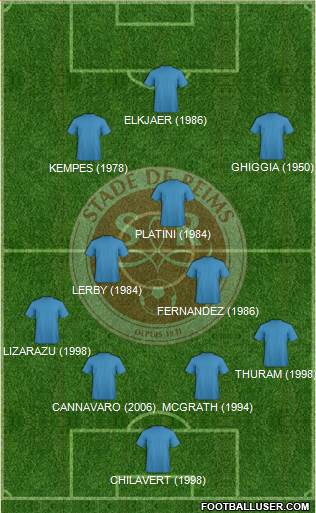
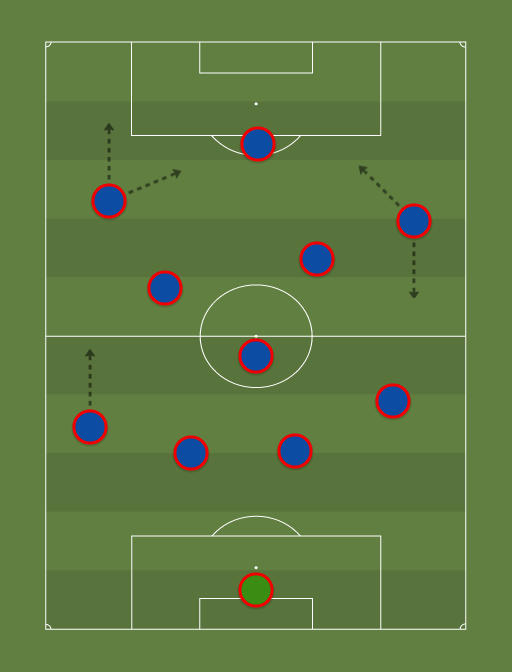
DOWNCAST - REMAKE OF FRANCE 58
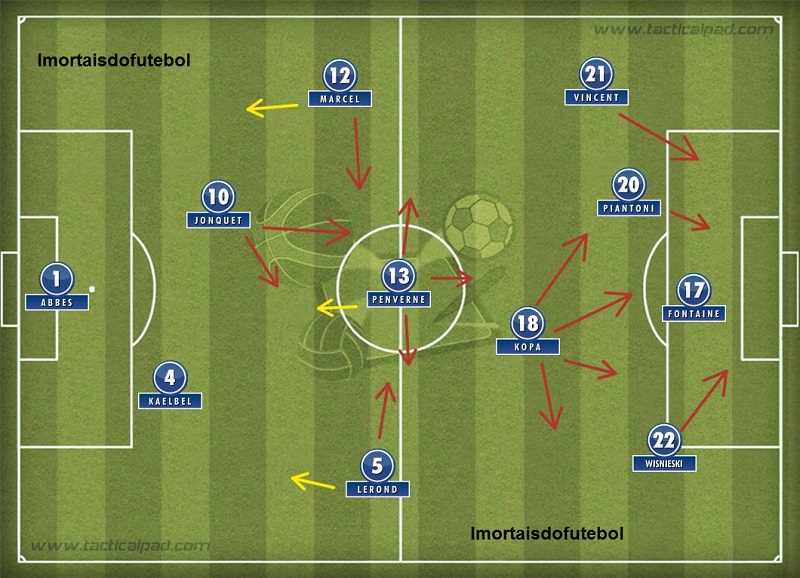
A striker holder of the record for most goals scored in a single WC tournament with 13 goals (also 4 assists)
FONTAINE 1958 - 1958 FIFA WC: Golden Shoe Best Forward - 21 caps: 30 Goals - Career 200 Goals/ 240 Games
Just Fontaine was the most prolific scorer in the Europe in the late 1950s. He scored four goals against former World Cup champion West Germany. He has also scored the third most goals of any player in the World Cup finals overall. Fontaine became the 2nd player after Alcides Ghiggia to score in every match of a WC. He was a classic forwardability to score from any angle, with both feet and his head. He played for Stade de Reims in their golden era alongside Raymond Kopa. Fontaine is forced to retire early at 29 y.o because of a recurring injury that effect his longevity was so short.
Henry reached his International Peak as a left wing-forward: pace, power and goals
HENRY 2000 - 2000 UEFA Euro Winner & part of the Tournament Team Best XI - Euro 2000 Final Man of the Match because Nesta, Cannavaro & co were unable to keep him under control - Career 321 Goals + 165 Assists / 695 Games - 117 caps with France: 51 Goals & 29 assists -
Henry 2000 was extremely fast and mobile. He started playing as a left-winger for Monaco and Juventus before being signed for Arsenal. His style of play is not to wait the ball in penalty box. Oppositely, He always tried to control the ball and find an occasion to make score or assist. Then he moved to Barcelona and changed position to left-wing-forward. He won the triple champs with the club in 2009.
Der Boss, The man who says NO to the Golden Team of Hungary: Man of the match in the WC Final 1954 (he scored a goal)
RAHN 1954 - International peak as a right wing-forward - 1954 FIFA WC Winner & 1954 WC Team Best XI - 40 caps with West Germany : 21 Goals
"The Boss" Helmut Rahn is one of the great legends in history of German football and the greatest German winger in history of World Cup, was the greatest German forward in the mid-50s, was sparked by the heroic antics of the German team during the 50’s. Particularly, a right-winger, Rahn showed his great performance in World Cup 1954 final, scores important twce goals and an assist help West Germany to win the game 3-2 over the apparently unbeatable Hungarian team. Rahn was notable for his mentality, team work ability and his powerful shooting. Rahn also finished in top ten Ballon'Dor in 1959. In 2004, 50 years after the Bern match, a life size statue of him was put up near Georg-Melches-Stadium.
The Ballon D'Or 1958 holder of the record for most assists in a single WC (9 assists)
KOPA 1958 - Right Attacking-Playmaking Midfielder - 1958 FIFA WC Team best 11 - Career 200 Goals/ 240 Games - 45 caps with France: 18 Goals + 20 Assists- 1958 FIFA World Cup Third Place
Raymond Kopa is the great legendary French football who is regarded as the finest playmaker in the World during the second half 1950s. Kopa was the progeny of a Polish immigrant family. He was a free-role playmaker who ran to many areas in attacking line, quick, agile and excellent in dribble combined with playmaking abilities. He played as attacking midfielder for Stade Reims in his early career during its glory years. After he with the club lost Real Madrid in European Cup final 1956, He was signed to the Santiago Bernabeu, played for them for three seasons primarily as right-winger and fortunately won European Cup all seasons. Kopa was an important key player as attacking midfielder to lead France finish third place in World Cup 1958 with his many assists to Just Fontaine who overshadowed him by scoring so many goals. Kopa left Real Madrid for financial considerations (!) to return to play for Stade Reims.
Another Collective King of the pass to support the trio
NETZER 1972 - Left-Attacking/Playmaking Midfielder
1972 European Championship Team of The Tournament
1972 Silver Ball European Footballer of The Year
2 Times German Footballer of The Year (1972, 1973)
"Karajan Of European football" was considered to be one of the greatest passers in the game's history. Iconic playmaker and is considered one of the most talented midfielders of all times, gaining a lot of attention with his long passes and pushes from deep within his own half of the pitch. Apart from his superior ball skills, his natural authority made him the undisputed leader of his team. His highlight in international club consists of UEFA runner-up with Gladbach and European Cup semi-finalist with Real Madrid. According to German footballer of the year voting, he was German midfielder of the year for three times. He was named in Bundesliga team of the season seven times.
The Brazilian Anchor who brought balance
ZITO 1962 - The guy who made the bridge between the defenders and the front 5
FIFA World Cup Winners (1958,1962) + 1962 FIFA World Cup All-Star Team
“The Manager” is one of the most successful and decorated defensive midfielders ever, was the greatest South American defensive midfielder in the first half 1960s and is the greatest defensive midfielder in history of Copa Libertadores Cup He was highly strong and tough in defensive role but rather slow. Zito was an organized midfielder, a pragmatic and claiming influence to his team and often filled with individualistic attacking talents. He was one of key players of Santos to achieve one of the most peak performance in history of South American club and played for only Santos club in his entire career. Zito was a fortunate Brazilian player to win twice World Cup as he was substituted to Dino Sani who got injury in 1958 and was almost lost his first team position to Zequinha just before the 1962 tournament.
The defence
SCHNELLINGER - World-Class full-back
World Cup Participation : 1958, 1962, 1966, 1970 (16 Games)
1966 FIFA World Cup Runner-Up +1970 FIFA World Cup Third Place
1962 FIFA World Cup All-Star Team + 1962 Bronze Ball European Footballer of The Year + 1962 German Footballer of The Year
3 Times European Defender of The Year (1962, 1963, 1964)
Karl-Heinz Schnellinger was the best defender in the World in the first half 1960s. He was a consistent world-class defender who mainly played as left-back in 4-4-2 system but he sometimes was used as sweeper for Germany which he was still rated in world-class in world cup 1970. He was noted for his superlatively positional play, tackling ability, physical power pace and his winning mentality. Moreover, Schnellinger also did offensively duty well especially his long passing. His best year was 1962 which was the only year he won 2 major individual awards. According to German Footballer of the year voting, He was German defender of the year only twice times. Schnellinger was voted in 5th, 11th and 12th Ballon'Dor between 1963 and 1965, respectively..
BLANC - Sweeper - EURO 96 BEST 11 (His prime IMO)
Nation : France, Caps : 97 Games (16 Goals)
1998 FIFA World Cup Champion + 2000 European Championship Winners
2 times UEFA Euro Best XI (1992,1996,)
Laurent Blanc was voted as the fourth greatest French player of century according to France Football’s poll. He was known as a surprisingly high-scoring defender, excellent anticipation, elegant on-the-ball skill style. He was a threat to the opposition’s goal from the air or from either foot. Blanc scored more than 133 goals in his career and is named as Inter Milan Player of The Year in 2000. Blanc was nominated in Ballon'Dor four times, finished best place at 14th in 1998.
KHURTISLAVA - CB - EURO 1972 TEAM OF THE TOURNAMENT
He was part of the USSR side that finished fourth at the 1966 FIFA World Cup, third at the 1972 Summer Olympics[2] and second in the 1972 UEFA European Championship. After the UEFA Euro 1972 along with his teammates by Soviet Union national football team — Revaz Dzodzuashvili and Evgeni Rudakov — he was included in the team of the tournament, where also were presented such great players like Franz Beckenbauer, Gerd Müller, Paul Breitner, Uli Hoeness and Günter Netzer. He was also one of the only two Georgians, alongside Alexandre Chivadze, to have captained the Soviet Union national football team. At the club level he played for FC Dynamo Tbilisi.
ANDRADE - RB - 1924 Olympics Games Best Player
World Cup Participation : 1930 (4 Games)
1930 FIFA World Cup Champion
3 Times Copa America Winners (1923, 1924, 1926)
Individual Achievement : 1926 Copa America Best Player
1930 FIFA World Cup All-Stars Team
“The Black Winder” Jose Leandro Andrade was the greatest footballer in the World during the middle 1920s, was credited with being an intelligent and honest player who never celebrated his goals. He was a football artist who could simply do anything with the ball. He was a tall guy with elastic movements, who always preferred the direct, elegant game without physical contact and was always ahead with his thoughts by several moves. He preferred to play a direct style without the physicality of many of his team mates. Andrade won his first Olympic gold medal at the 1924 Olympic football tournament in Paris. He was recognized as being the first black international football player to play Olympic football, once perform phenomenon dribbling get through seven opponents. Despite not being at his peak he managed to be one of Uruguay's best players as they won the 1930 World Cup. At the end of the tournament he was selected in the All-Star team. In 1994 he was selected by France Football as number ten in their World Cup Top-100. He was also voted 29th World’s player of century by IFFHS’s poll.
Ladislao Mazurkiewicz WC 1970 - 1970 FIFA World Cup Best Goalkeeper
Caps : 36 Games (15 Clean Sheets) + 1967 Copa America Winner + 1999 IFFHS Uruguay Goalkeeper of The Century
Ladislao Mazukiewicz is one of the best goalkeepers ever to come from the Americas. His early career with Penarol saw an impressive victory with two consecutive unbeaten seasons in 1967 and 1968. Marzurkiewicz helped the Uruguay national team to qualify to the semifinals of the 1970 World Cup. He totally kept five clean sheets in World Cup final tournament. He notably won six international games in row without concede goal between 1969 and 1970. Mazurkiewicz was voted by IFFHS’s poll 5th South American’s greatest goalkeeper of all-time and 12th World’s greatest goalkeeper of the century.
---> All the players reached their international peak in a similar role and tactical system.
FRANCE 1930 - THE FIRST FRANCE TEAM...
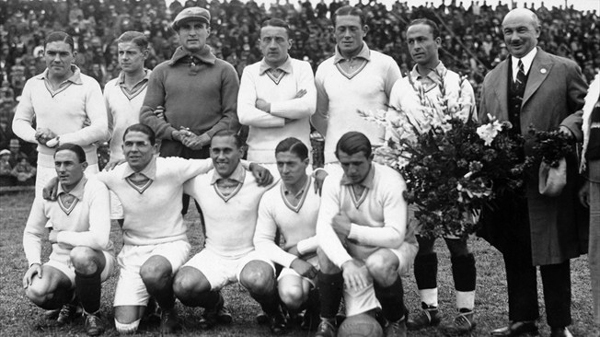
...BUT FRANCE 1958 WAS THE FIRST GREAT TEAM WITH KOPA - WC 3rd PLACE -

FRANCE 1958 WORLD CUP THIRD PLACE
Standing: Kaelbel, Penverne, Jonquet, Marcel, Remetter and Lerond.
Bended: Wisnieski, Fontaine, Kopa, Piantoni and Vincent.
This French 1958 NT was one of the most talented of the WC and in the french football history.
In the semi final, after only 30 min their best defender and one of the most talented player Robert Jonquet broke his leg in a shock with the "bull" Vava. At this time, the substitutions were not authorized, so France finish the game at 10 players. At this moment of the game, the score was 1-1 and only 2-1 for Brazil at half time.
Noone knows really what could happen if France played all the match with 11 players. One thing is sure, the Brazil had to play his best game of WC during this semi final to beat France. After that, for the third place game, France burst the WC holder West Germany 6-3
This France NT was really a top one, led by their glory legend, the old "captain" Roger Marche who held during a long time the record of caps for France (until ths 80's !).
France finish with the best goalscorer of the WC : Just Fontaine who still hold the record of goal scorind in one single WC, and the best player of that tournament Raymond Kopa.
FRANCE 1982-86 WAS THE SECOND FRANCE TEAM WITH PLATINI

FRANCE 1994-01 WAS THE GOLDEN AGE WITH ZIDANE, HENRY, BLANC

NO ROOM FOR AMATEURISM: MY PLAYERS HAVE THE RIGHT POSITIONONG

WC 54 FINAL


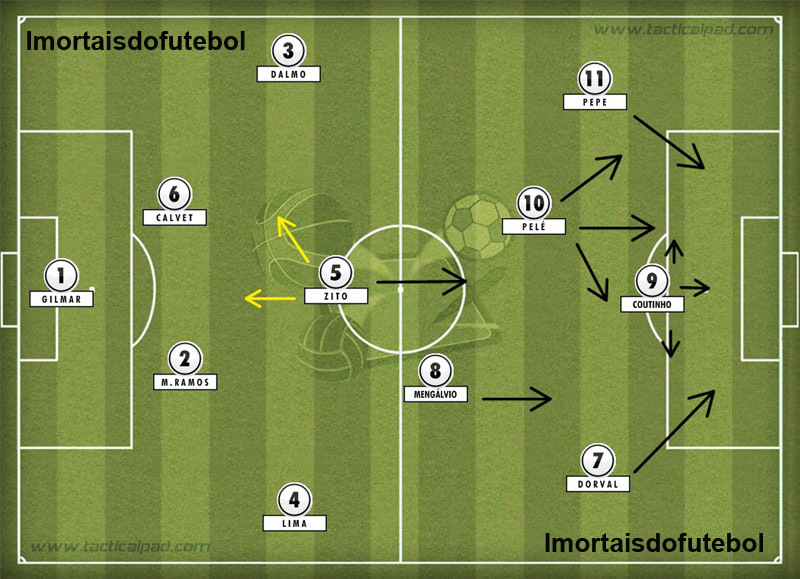
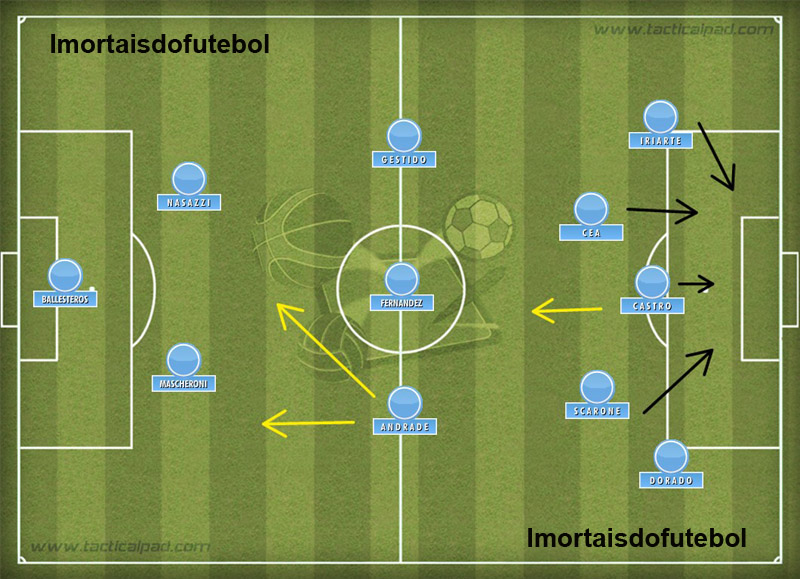
Substitutes: Schiaffino, Jorginho, Hassler
Formation: lopsided 4-3-3
Tactical Synopsis: A moderate-deep defensive line shielded by a rugged central midfield pairing and augmented by tireless workers further up the pitch. Fast transitions and a high tempo attacking style orchestrated by Platini.
The team is built around Michel Platini at the absolute peak of his powers. Platini in his Euro ’84 pomp is without question one of the greatest match winners in this draft – a playmaker of outstanding influence and passing range, and a lethal goalscorer who hit 9 goals in 5 games. We’ve given him free rein as playmaker here, with complete licence to roam and to orchestrate our attacking game. Platini’s supporting cast in midfield and attack should complement his game nicely:
1) Elkjaer: The bruising, bullying battering ram who will lead the line while Platini starts moves from deeper areas, and moreover an extremely mobile livewire who will drag defenders all over the place to create space for Platini and Kempes to surge into.
2) Kempes: Another bona fide match-winner, who shares Platini’s penchant for quick tempo, thrusting attacking moves. A wonderful outlet for Platini’s passing, and his chaotic, hyperactive style of dribbling and quick interchanges should create plenty of opportunities for Platini in return.
3) Ghiggia: As an orthodox winger he’s in some ways atypical for a Platini side, but I’d argue that some consistent, genuine width will not only provide Platini with a constant outlet, but stretch the opposition defence and decongest the middle for Le Roi.
4) Fernandez and Lerby: A pair of defensively resolute, exceptionally hard-working midfielders who strike the right balance between having the quality in possession themselves without competing with Platini for the playmaker mantle. Lerby in particular had a superb range of passing but had no problem deferring to the likes of Arnesen and Olsen when necessary and allowing his other qualities to come to the fore.
Our defence is excellent by any standard, and elevated even higher by the parameters of this draft. In terms of World Cup peaks from defenders, Cannavaro in 2006 and Thuram in 1998 both have credible claims to be the best ever, and are certainly in the top echelon. McGrath’s 1994 tournament is the stuff of legend here in Ireland. Past his peak, ravaged with alcohol problems and bad knees, suffering terribly with a shoulder injury on top of that, he still repelled Baggio’s Italy to seal a famous 1-0 win for Ireland. Lizarazu, veteran of an extremely narrow France setup in 1998, will similarly provide some of our attacking width here.
Why We’ll Win:
Without knowing Downcast’s line up there’s an element of guess work here, but I see two main advantages for us:
1) Platini given free rein: We’ve cleared the decks here for Platini – no competing playmakers, just a supporting cast who offer different qualities, from the movement and ball-carrying of Kempes and Ghiggia to the robust ball-winning of Lerby and Fernandez. In contrast, Downcast looks likely to line up with some configuration of Netzer/Kopa/Albert, and there may be question marks as to whether he can get the best from them.
2) Midfield Balance/Regaining Possession: Those multiple playmakers in Downcast’s squad may also come at the price of a balanced midfield – Zito looks like his only defensively orientated player, and he’ll likely have too much to handle versus Platini and Kempes. Platini himself was probably more effective defensively than any of Netzer/Kopa/Albert, and moreover he’s got the heavyweight pairing of Lerby and Fernandez to do most of the heavy lifting. Elsewhere, both Kempes and Elkjaer were renowned for hounding the opposition when out of possession, whereas I don’t see a similar level of graft permeating the opposition team.
Short Profiles and Tournament Credentials:
Jose Luis Chilavert (WC 98): Conceded only 2 goals in 4 games (including 1 in extra time to the eventual winners), as one of Paraguay’s key players along with Gamarra. Made the All Star squad, and impressed with his shot-stopping, leadership and ability in possession.
Lilian Thuram (WC 98): A cornerstone of the miserly France defence that conceded only 2 goals en route to their WC win, this defensive full back memorably took matters into his own hands in the semi-final vs Croatia to win the game with two late goals. His WC performances helped him to a 7th place finish in that year’s Ballon d’Or rankings, the highest of all the French defenders.
Bizente Lizarazu (WC 98): Thuram’s partner in crime on the other flank in that France defence, Lizarazu also ranked in the 1998 Ballon d’Or, and displayed his customary excellence at both ends of the pitch, even popping up to score against Saudi Arabia.
Fabio Cannavaro (WC 06): Cannavaro’s performances in winning this WC effectively won him the Ballon d’Or, and place him squarely at the top of the heap in terms of defenders in this pool. Of the Italy defence that conceded only an own goal and a disputed penalty all tournament, only he and Buffon started every match, with Cannavaro’s MOTM performance vs Germany being the apex of an individually flawless tournament.
Paul McGrath (WC 94): A national icon and a personal hero of mine, McGrath’s heroic resistance act against Baggio’s Italy ranks amongst the greatest defensive displays I’ve personally seen. He also turned in a dominant performance against Norway, and was somewhat unfortunate to have a goal disallowed against Holland after a lovely piece of skill.
Luis Fernandez (WC 86): Fernandez supplanted the gifted Bernard Genghini in the France lineup to provide the balance and defensive solidity that enabled Le Carre Magique to stake a claim as one of the all-time great midfields. A resolute and composed presence both Euro ‘84 and the WC two years later, his individual performance in the WC is rated a little higher.
Soren Lerby (EURO 84): One of several of my players who excelled in both Euro ’84 and WC ’86. I’ve opted for the 84 version here simply as I’ve watched more of him and he seemed to play deeper and more centrally. A dogged, hyper-committed box to box player, Lerby was integral to the one midfield in that Euros that came anywhere close to keeping Platini under the cosh, impressing with his excellent range of passing as well as his defensive work.
Michel Platini (EURO 84): The jewel in the crown. Only Maradona can claim to have surpassed Platini’s glorious single tournament peak in 1984, where he orchestrated France’s triumph as a playmaker of the highest calibre, scoring 9 goals in 5 matches along the way.
Alcides Ghiggia (WC 50): “Only three people have silenced the Maracanã. The Pope, Frank Sinatra – and me.” Ghiggia earned himself a place in footballing folklore with his match winning interventions against a massively favoured Brazil, assisting Schiaffino for Uruguay’s equaliser before scoring the winner himself. A quick, nimble right winger by trade, Ghiggia falls squarely in the spirit of this draft, elevating himself above even his usual, stellar level to score 4 goals in 4 World Cup games and emerge as a match winner on the biggest occasion of all.
Mario Kempes (WC 78): Top scorer and best player at WC ’78, Kempes caught fire as the tournament progressed, scoring 3 braces in Argentina’s last 4 matches to win the tournament. A dynamic, explosive attacker, Kempes impressed with his surging dribbles, eye for goal and irrepressible workrate.
Preben Elkjaer (WC 86): The attacking spearhead of that thrilling Danish Dynamite team, Elkjaer was both a flair player and a prototypical modern centre forward, allying a bruising physique and rampaging dribbling style with dynamic movement and a superb eye for bringing teammates into play. He belied his occasionally patchy overall record as a goalscorer to notch 4 goals in 4 games during the tournament, memorably eviscerating Uruguay with a stunning performance in Denmark’s 6-1 victory.
Lilian Thuram (WC 98): A cornerstone of the miserly France defence that conceded only 2 goals en route to their WC win, this defensive full back memorably took matters into his own hands in the semi-final vs Croatia to win the game with two late goals. His WC performances helped him to a 7th place finish in that year’s Ballon d’Or rankings, the highest of all the French defenders.
Bizente Lizarazu (WC 98): Thuram’s partner in crime on the other flank in that France defence, Lizarazu also ranked in the 1998 Ballon d’Or, and displayed his customary excellence at both ends of the pitch, even popping up to score against Saudi Arabia.
Fabio Cannavaro (WC 06): Cannavaro’s performances in winning this WC effectively won him the Ballon d’Or, and place him squarely at the top of the heap in terms of defenders in this pool. Of the Italy defence that conceded only an own goal and a disputed penalty all tournament, only he and Buffon started every match, with Cannavaro’s MOTM performance vs Germany being the apex of an individually flawless tournament.
Paul McGrath (WC 94): A national icon and a personal hero of mine, McGrath’s heroic resistance act against Baggio’s Italy ranks amongst the greatest defensive displays I’ve personally seen. He also turned in a dominant performance against Norway, and was somewhat unfortunate to have a goal disallowed against Holland after a lovely piece of skill.
Luis Fernandez (WC 86): Fernandez supplanted the gifted Bernard Genghini in the France lineup to provide the balance and defensive solidity that enabled Le Carre Magique to stake a claim as one of the all-time great midfields. A resolute and composed presence both Euro ‘84 and the WC two years later, his individual performance in the WC is rated a little higher.
Soren Lerby (EURO 84): One of several of my players who excelled in both Euro ’84 and WC ’86. I’ve opted for the 84 version here simply as I’ve watched more of him and he seemed to play deeper and more centrally. A dogged, hyper-committed box to box player, Lerby was integral to the one midfield in that Euros that came anywhere close to keeping Platini under the cosh, impressing with his excellent range of passing as well as his defensive work.
Michel Platini (EURO 84): The jewel in the crown. Only Maradona can claim to have surpassed Platini’s glorious single tournament peak in 1984, where he orchestrated France’s triumph as a playmaker of the highest calibre, scoring 9 goals in 5 matches along the way.
Alcides Ghiggia (WC 50): “Only three people have silenced the Maracanã. The Pope, Frank Sinatra – and me.” Ghiggia earned himself a place in footballing folklore with his match winning interventions against a massively favoured Brazil, assisting Schiaffino for Uruguay’s equaliser before scoring the winner himself. A quick, nimble right winger by trade, Ghiggia falls squarely in the spirit of this draft, elevating himself above even his usual, stellar level to score 4 goals in 4 World Cup games and emerge as a match winner on the biggest occasion of all.
Mario Kempes (WC 78): Top scorer and best player at WC ’78, Kempes caught fire as the tournament progressed, scoring 3 braces in Argentina’s last 4 matches to win the tournament. A dynamic, explosive attacker, Kempes impressed with his surging dribbles, eye for goal and irrepressible workrate.
Preben Elkjaer (WC 86): The attacking spearhead of that thrilling Danish Dynamite team, Elkjaer was both a flair player and a prototypical modern centre forward, allying a bruising physique and rampaging dribbling style with dynamic movement and a superb eye for bringing teammates into play. He belied his occasionally patchy overall record as a goalscorer to notch 4 goals in 4 games during the tournament, memorably eviscerating Uruguay with a stunning performance in Denmark’s 6-1 victory.
-----------------Team Pat---------------------------------------------Team Downcast


DOWNCAST - REMAKE OF FRANCE 58

A striker holder of the record for most goals scored in a single WC tournament with 13 goals (also 4 assists)
FONTAINE 1958 - 1958 FIFA WC: Golden Shoe Best Forward - 21 caps: 30 Goals - Career 200 Goals/ 240 Games
Just Fontaine was the most prolific scorer in the Europe in the late 1950s. He scored four goals against former World Cup champion West Germany. He has also scored the third most goals of any player in the World Cup finals overall. Fontaine became the 2nd player after Alcides Ghiggia to score in every match of a WC. He was a classic forwardability to score from any angle, with both feet and his head. He played for Stade de Reims in their golden era alongside Raymond Kopa. Fontaine is forced to retire early at 29 y.o because of a recurring injury that effect his longevity was so short.
Henry reached his International Peak as a left wing-forward: pace, power and goals
HENRY 2000 - 2000 UEFA Euro Winner & part of the Tournament Team Best XI - Euro 2000 Final Man of the Match because Nesta, Cannavaro & co were unable to keep him under control - Career 321 Goals + 165 Assists / 695 Games - 117 caps with France: 51 Goals & 29 assists -
Henry 2000 was extremely fast and mobile. He started playing as a left-winger for Monaco and Juventus before being signed for Arsenal. His style of play is not to wait the ball in penalty box. Oppositely, He always tried to control the ball and find an occasion to make score or assist. Then he moved to Barcelona and changed position to left-wing-forward. He won the triple champs with the club in 2009.
Der Boss, The man who says NO to the Golden Team of Hungary: Man of the match in the WC Final 1954 (he scored a goal)
RAHN 1954 - International peak as a right wing-forward - 1954 FIFA WC Winner & 1954 WC Team Best XI - 40 caps with West Germany : 21 Goals
"The Boss" Helmut Rahn is one of the great legends in history of German football and the greatest German winger in history of World Cup, was the greatest German forward in the mid-50s, was sparked by the heroic antics of the German team during the 50’s. Particularly, a right-winger, Rahn showed his great performance in World Cup 1954 final, scores important twce goals and an assist help West Germany to win the game 3-2 over the apparently unbeatable Hungarian team. Rahn was notable for his mentality, team work ability and his powerful shooting. Rahn also finished in top ten Ballon'Dor in 1959. In 2004, 50 years after the Bern match, a life size statue of him was put up near Georg-Melches-Stadium.
The Ballon D'Or 1958 holder of the record for most assists in a single WC (9 assists)
KOPA 1958 - Right Attacking-Playmaking Midfielder - 1958 FIFA WC Team best 11 - Career 200 Goals/ 240 Games - 45 caps with France: 18 Goals + 20 Assists- 1958 FIFA World Cup Third Place
Raymond Kopa is the great legendary French football who is regarded as the finest playmaker in the World during the second half 1950s. Kopa was the progeny of a Polish immigrant family. He was a free-role playmaker who ran to many areas in attacking line, quick, agile and excellent in dribble combined with playmaking abilities. He played as attacking midfielder for Stade Reims in his early career during its glory years. After he with the club lost Real Madrid in European Cup final 1956, He was signed to the Santiago Bernabeu, played for them for three seasons primarily as right-winger and fortunately won European Cup all seasons. Kopa was an important key player as attacking midfielder to lead France finish third place in World Cup 1958 with his many assists to Just Fontaine who overshadowed him by scoring so many goals. Kopa left Real Madrid for financial considerations (!) to return to play for Stade Reims.
Another Collective King of the pass to support the trio
NETZER 1972 - Left-Attacking/Playmaking Midfielder
1972 European Championship Team of The Tournament
1972 Silver Ball European Footballer of The Year
2 Times German Footballer of The Year (1972, 1973)
"Karajan Of European football" was considered to be one of the greatest passers in the game's history. Iconic playmaker and is considered one of the most talented midfielders of all times, gaining a lot of attention with his long passes and pushes from deep within his own half of the pitch. Apart from his superior ball skills, his natural authority made him the undisputed leader of his team. His highlight in international club consists of UEFA runner-up with Gladbach and European Cup semi-finalist with Real Madrid. According to German footballer of the year voting, he was German midfielder of the year for three times. He was named in Bundesliga team of the season seven times.
The Brazilian Anchor who brought balance
ZITO 1962 - The guy who made the bridge between the defenders and the front 5
FIFA World Cup Winners (1958,1962) + 1962 FIFA World Cup All-Star Team
“The Manager” is one of the most successful and decorated defensive midfielders ever, was the greatest South American defensive midfielder in the first half 1960s and is the greatest defensive midfielder in history of Copa Libertadores Cup He was highly strong and tough in defensive role but rather slow. Zito was an organized midfielder, a pragmatic and claiming influence to his team and often filled with individualistic attacking talents. He was one of key players of Santos to achieve one of the most peak performance in history of South American club and played for only Santos club in his entire career. Zito was a fortunate Brazilian player to win twice World Cup as he was substituted to Dino Sani who got injury in 1958 and was almost lost his first team position to Zequinha just before the 1962 tournament.
The defence
SCHNELLINGER - World-Class full-back
World Cup Participation : 1958, 1962, 1966, 1970 (16 Games)
1966 FIFA World Cup Runner-Up +1970 FIFA World Cup Third Place
1962 FIFA World Cup All-Star Team + 1962 Bronze Ball European Footballer of The Year + 1962 German Footballer of The Year
3 Times European Defender of The Year (1962, 1963, 1964)
Karl-Heinz Schnellinger was the best defender in the World in the first half 1960s. He was a consistent world-class defender who mainly played as left-back in 4-4-2 system but he sometimes was used as sweeper for Germany which he was still rated in world-class in world cup 1970. He was noted for his superlatively positional play, tackling ability, physical power pace and his winning mentality. Moreover, Schnellinger also did offensively duty well especially his long passing. His best year was 1962 which was the only year he won 2 major individual awards. According to German Footballer of the year voting, He was German defender of the year only twice times. Schnellinger was voted in 5th, 11th and 12th Ballon'Dor between 1963 and 1965, respectively..
BLANC - Sweeper - EURO 96 BEST 11 (His prime IMO)
Nation : France, Caps : 97 Games (16 Goals)
1998 FIFA World Cup Champion + 2000 European Championship Winners
2 times UEFA Euro Best XI (1992,1996,)
Laurent Blanc was voted as the fourth greatest French player of century according to France Football’s poll. He was known as a surprisingly high-scoring defender, excellent anticipation, elegant on-the-ball skill style. He was a threat to the opposition’s goal from the air or from either foot. Blanc scored more than 133 goals in his career and is named as Inter Milan Player of The Year in 2000. Blanc was nominated in Ballon'Dor four times, finished best place at 14th in 1998.
KHURTISLAVA - CB - EURO 1972 TEAM OF THE TOURNAMENT
He was part of the USSR side that finished fourth at the 1966 FIFA World Cup, third at the 1972 Summer Olympics[2] and second in the 1972 UEFA European Championship. After the UEFA Euro 1972 along with his teammates by Soviet Union national football team — Revaz Dzodzuashvili and Evgeni Rudakov — he was included in the team of the tournament, where also were presented such great players like Franz Beckenbauer, Gerd Müller, Paul Breitner, Uli Hoeness and Günter Netzer. He was also one of the only two Georgians, alongside Alexandre Chivadze, to have captained the Soviet Union national football team. At the club level he played for FC Dynamo Tbilisi.
ANDRADE - RB - 1924 Olympics Games Best Player
World Cup Participation : 1930 (4 Games)
1930 FIFA World Cup Champion
3 Times Copa America Winners (1923, 1924, 1926)
Individual Achievement : 1926 Copa America Best Player
1930 FIFA World Cup All-Stars Team
“The Black Winder” Jose Leandro Andrade was the greatest footballer in the World during the middle 1920s, was credited with being an intelligent and honest player who never celebrated his goals. He was a football artist who could simply do anything with the ball. He was a tall guy with elastic movements, who always preferred the direct, elegant game without physical contact and was always ahead with his thoughts by several moves. He preferred to play a direct style without the physicality of many of his team mates. Andrade won his first Olympic gold medal at the 1924 Olympic football tournament in Paris. He was recognized as being the first black international football player to play Olympic football, once perform phenomenon dribbling get through seven opponents. Despite not being at his peak he managed to be one of Uruguay's best players as they won the 1930 World Cup. At the end of the tournament he was selected in the All-Star team. In 1994 he was selected by France Football as number ten in their World Cup Top-100. He was also voted 29th World’s player of century by IFFHS’s poll.
Ladislao Mazurkiewicz WC 1970 - 1970 FIFA World Cup Best Goalkeeper
Caps : 36 Games (15 Clean Sheets) + 1967 Copa America Winner + 1999 IFFHS Uruguay Goalkeeper of The Century
Ladislao Mazukiewicz is one of the best goalkeepers ever to come from the Americas. His early career with Penarol saw an impressive victory with two consecutive unbeaten seasons in 1967 and 1968. Marzurkiewicz helped the Uruguay national team to qualify to the semifinals of the 1970 World Cup. He totally kept five clean sheets in World Cup final tournament. He notably won six international games in row without concede goal between 1969 and 1970. Mazurkiewicz was voted by IFFHS’s poll 5th South American’s greatest goalkeeper of all-time and 12th World’s greatest goalkeeper of the century.
---> All the players reached their international peak in a similar role and tactical system.
FRANCE 1930 - THE FIRST FRANCE TEAM...

...BUT FRANCE 1958 WAS THE FIRST GREAT TEAM WITH KOPA - WC 3rd PLACE -

FRANCE 1958 WORLD CUP THIRD PLACE
Standing: Kaelbel, Penverne, Jonquet, Marcel, Remetter and Lerond.
Bended: Wisnieski, Fontaine, Kopa, Piantoni and Vincent.
This French 1958 NT was one of the most talented of the WC and in the french football history.
In the semi final, after only 30 min their best defender and one of the most talented player Robert Jonquet broke his leg in a shock with the "bull" Vava. At this time, the substitutions were not authorized, so France finish the game at 10 players. At this moment of the game, the score was 1-1 and only 2-1 for Brazil at half time.
Noone knows really what could happen if France played all the match with 11 players. One thing is sure, the Brazil had to play his best game of WC during this semi final to beat France. After that, for the third place game, France burst the WC holder West Germany 6-3
This France NT was really a top one, led by their glory legend, the old "captain" Roger Marche who held during a long time the record of caps for France (until ths 80's !).
France finish with the best goalscorer of the WC : Just Fontaine who still hold the record of goal scorind in one single WC, and the best player of that tournament Raymond Kopa.
FRANCE 1982-86 WAS THE SECOND FRANCE TEAM WITH PLATINI

FRANCE 1994-01 WAS THE GOLDEN AGE WITH ZIDANE, HENRY, BLANC

NO ROOM FOR AMATEURISM: MY PLAYERS HAVE THE RIGHT POSITIONONG

WC 54 FINAL









